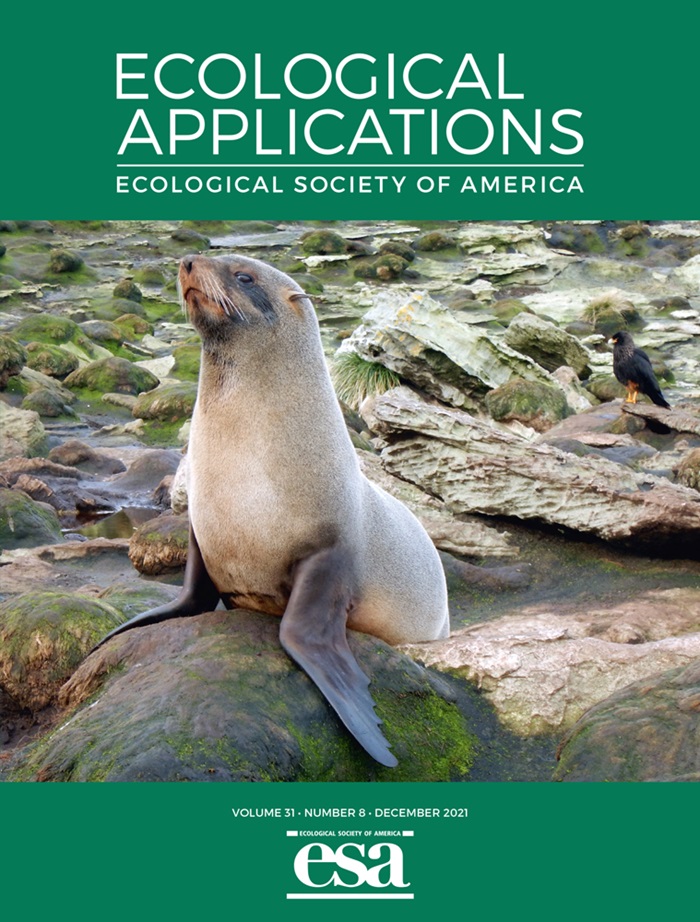树木年代学揭示了干旱河流流域河岸森林对水管理的响应。
IF 4.3
2区 环境科学与生态学
Q1 ECOLOGY
引用次数: 0
摘要
干旱气候中的河岸廊道维持着原本不适宜居住的环境中的生命,创造了具有生态和文化重要性的区域。然而,干旱气候下的河流往往以牺牲河流的淡水生物多样性为代价来为人类提供水。本研究以成熟棉树年轮生长和碳同位素组成作为河流生态系统健康的生物指标,评价了生态系统对河流流量管理的响应。我们研究了流量管理对美国内华达州特拉基河下游的生态影响,这条河流经一个干旱气候盆地,几十年来一直受到大流量转移和管理的影响。特别注意的是1973年和1982年的重大诉讼的影响,这些诉讼恢复了自1905年以来逐渐干涸的河流的春季和夏季流量。改道下游大部分成熟乔木(50 ~ 30岁)对水流恢复响应强烈,年轮平均增长160%。在所测试的流量指标中,年平均流量对棉杨生长的正向影响最大,春季融雪衰退的各个方面也有影响。降水也与棉杨生长有关,主要是在1973年以前的管理期间,当时旱季流量严重有限。并不是所有的洪泛区树木对流量指标的变化都有相似的反应,这表明洪泛区土壤中树木的个体属性和异质性对树木的生长非常重要。结果提供了有希望的证据,表明水流恢复可以导致河岸森林生产力的可测量的改善,尽管具体地点的考虑因素,包括河漫滩上的河道形式和位置,在确定对水流模式变化的响应时很重要。本文章由计算机程序翻译,如有差异,请以英文原文为准。
Dendrochronology reveals the response of a riparian forest to water management in an arid river basin.
Riparian corridors in arid climates sustain life in otherwise inhospitable environments, creating zones of ecological and cultural importance. However, rivers in arid climates are often managed to provide water for human populations at the expense of a river's freshwater biodiversity. In this study, ecosystem response to river flow management is assessed using mature cottonwood tree-ring growth and carbon isotope composition as bio-indicator proxies for river ecosystem health. We examine the ecological impacts of flow management on the Lower Truckee River in Nevada, USA, which runs through an arid-climate basin that has been subject to decades of heavy flow diversion and management. Particular attention is given to the effects of major lawsuits in 1973 and 1982 that restored spring and summer flows to the river following progressive dewatering since 1905. Most mature trees (>30 years old) downstream of diversions responded strongly to restored flows, with average annual tree-ring growth increases of 160%. Among tested streamflow metrics, average annual flow had the strongest positive influence on cottonwood growth, and aspects of the spring snowmelt recession were also influential. Precipitation was also linked with cottonwood growth, primarily during the period of management before 1973 when dry season flows were severely limited. Not all floodplain trees responded similarly to changes in flow metrics, suggesting that individual tree attributes and heterogeneity in floodplain soils are highly important to tree growth. Results offer promising evidence that flow restoration can lead to measurable improvement in riparian forest productivity, although site-specific considerations including channel form and location on the floodplain are important in determining response to changes in flow patterns.
求助全文
通过发布文献求助,成功后即可免费获取论文全文。
去求助
来源期刊

Ecological Applications
环境科学-环境科学
CiteScore
9.50
自引率
2.00%
发文量
268
审稿时长
6 months
期刊介绍:
The pages of Ecological Applications are open to research and discussion papers that integrate ecological science and concepts with their application and implications. Of special interest are papers that develop the basic scientific principles on which environmental decision-making should rest, and those that discuss the application of ecological concepts to environmental problem solving, policy, and management. Papers that deal explicitly with policy matters are welcome. Interdisciplinary approaches are encouraged, as are short communications on emerging environmental challenges.
 求助内容:
求助内容: 应助结果提醒方式:
应助结果提醒方式:


